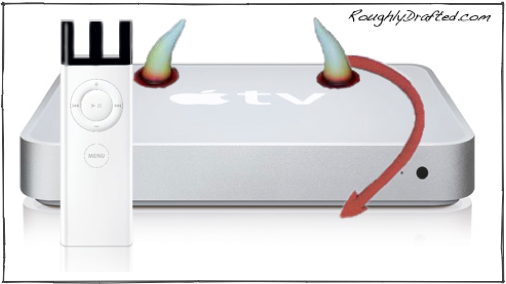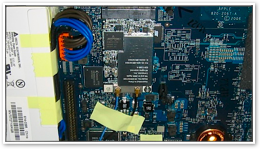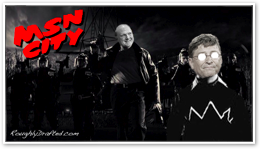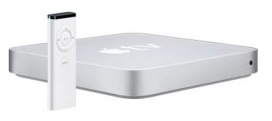

Ten Myths of the Apple TV: 5.1 Audio
Almost three months ago, Ten Myths of Apple iPhone overturned misinformation on that device before it could get started, although self-styled analysts kept trying to perpetuate them for months afterward.
The iPhone isn’t out for another three months but the Apple TV is here now; as a follow up to Inside Apple TV, here’s Ten Myths of the Apple TV, relating to 5.1 audio, comparisons with the Xbox, cables, pricing, widescreen, hardware, software, and even its devilish remote.
Myth 1: Apple TV can't play 5.1 audio!
Gizmodo, in its “Apple TV: Niggling Questions Answered” reports:
"Apple TV supports Dolby Pro Logic II surround sound [...] but it does not feature 5.1 discrete audio (sorry DTS lovers). Technically, it plays back AAC-LC audio up to 160 Kbps, which is then extrapolated to 5.1 channels."
Yikes, that’s wrong on nearly every count. Where to begin?
For starters, what's 5.1 audio? AC3 and DTS are two encoding systems for recording 6 channels of sound:
-
•Stereo front left and right channels (for primary sound)
-
•Mono center channel (for dialog)
-
•Stereo rear left and right channels (for surround effects)
-
•Subwoofer channel (for bass)
Since the subwoofer only provides low frequency sound, the six channels are stated as “5.1” to indicate five full audio channels and one special purpose subwoofer-only channel.
Sources of 5.1 Audio
The DVD specification requires that all players support both AC3 and DTS, and that movies provide minimally an AC3 soundtrack, with DTS sound as an option. AC3 is a Dolby format, also called Dolby Digital. DTS is a rival surround format; both are consumer versions of audio formats originally created for theaters.
Both AC3 and DTS audio are synthetically created and enhanced for movies by sound editors; movies are not filmed with six mics recording directly onto film, so there is nothing “real” about any surround sound format.
Movie container files like MP4 and AVI can also embed AC3 or DTS sound, and digitally encoded 5.1 sound can also be simply saved to a standalone file. DTS audio is commonly saved as a raw WAV file, for example.
DVD players and computers playing 5.1 encoded files could conceivably output the six channels of audio to six speakers themselves, but more typically they simply output the digitally encoded audio to an AC3/DTS receiver.
The receiver then decodes the 5.1 audio into six channels and distributes it to six speakers. Only a single receiver needs to do this, because it would be absurd to wire up multiple devices to one's 5.1 speakers all in parallel.
So really, the Apple TV doesn't need to decode 5.1 audio, it only needs to hand the surround audio stream to a receiver than can decode those formats. Can it do this?
Pro Logic Audio on Movies from iTunes
The videos Apple currently sells in iTunes use Dolby Surround Pro Logic, a surround system which provides four discreet sound channels:
-
•Stereo front left and right (for primary sound)
-
•Mono center channel (for dialog)
-
•Mono rear channel (for surround effects)
But the Apple TV only has stereo connectors; how can it output four channels over a single stereo pair? Pro Logic matrixes four separate sound signals on two cables. That allows stereo receivers to get playable stereo sound, while receivers that can decode Pro Logic can extract all four channels to distribute as surround sound.
Pro Logic systems with 5.1 speakers play the rear mono channel out both rear speakers, and send low frequency sound to the subwoofer, so the difference between Pro Logic and AC3/DTS content is not dramatic over the same set of 5.1 speakers.
DTS 5.1 from Apple TV
In addition to stereo cables, Apple TV also features a Toslink digital optical port. Since we can send raw digital audio data over the Apple TV's optical output, can't we send DTS digitally encoded 5.1 as well?
Of course we can. Download a DTS sample file in WAV format, drop it into iTunes, and Apple TV will happily sync it and play it. Unlike Pro Logic audio, it will sound like static over regular stereo speakers, but hooked up to a DTS receiver, it is decoded into 5.1 channels of sound and played back in real DTS 5.1 surround.
The only limitation with DTS 5.1 sound right now is that Apple isn't offering it on its own movie downloads. The Apple TV can certainly “do it,” because it doesn't have to “do” anything; it merely passes it on to the 5.1 DTS decoder that anyone with 5.1 surround speakers already has.
The PlayStation and Xbox models with digital surround sound similarly output AC3 data over their Toslink optical outputs to a receiver to decode into six channels.
iTunes’ Pro Logic vs DVD’s AC3 and DTS
Most users won't notice the difference between Dolby Pro Logic's four channels + subwoofer, and AC3/DTS' five channels + subwoofer.
If Apple added AC3/DTS sound to iTunes movies, consumers would notice that movies take longer to download.
The other problem is that many people don’t have AC3/DTS speakers, so Apple would have to license a decoder so that the Apple TV could downconvert that digital 5.1 audio into regular stereo. In fact, the majority of 5.1 sound on DVDs is played back in regular stereo by end users. What a waste!
DVDs have 4-8 GBs of space to fill, so offering a variety of soundtracks using older compression schemes is not an issue, but Internet downloads are complicated by every extra bit of unnecessary data they have to include.
Apple isn’t streaming DVDs over the Internet, it’s engineering a new system optimized for downloads. DVDs were never designed to be efficient enough to stream over the Internet.
Don’t Blame QuickTime!
On MacInTouch, readers worried about 5.1 audio were quick to blame QuickTime. John Lockwood wrote, "The consensus is that this is due to limitations in QuickTime rather than the hardware."
QuickTime however, has no problem playing back DTS multichannel sound encoded in a file out through the Toslink digital audio ports already on most Macs and the Apple TV. There is nothing for QuickTime to do; it simply plays a WAV file, which an outside DTS unit decodes into multiple channels of sound.
People downloading movies from iTunes want something that just works, not the requirement that they install a DTS receiver. DTS and AC3 aren’t backward compatible with stereo, but Pro Logic is. Downloads simply don’t have room for two or three full soundtracks, let alone using older and less efficient codecs designed for DVDs.
Surround Sound Encoding on Audio Downloads
The remaining issue is finding content with 5.1 encoding. The most common source for movies with AC3 audio is DVD. Macs with Toslink digital outputs can play DVD's AC3 or DTS audio out to a receiver for 5.1 decoding.
The Apple TV doesn't play DVDs; it plays movie files. Playing movie downloads with surround sound requires tighter compression and an audio format that is backward compatible with standard stereo receivers.
And that's the problem: AC3 isn't really a good codec for surround sound in movie files because it uses a fixed bit rate. The newer AAC--developed by Dolby to succeed AC3--also supports 5.1 (or more) channels of audio, and delivers better quality at the same bitrate.
Apple is not going to add the older AC3 to iTunes downloads because AC3 is a fat, old audio format that is only suited to DVD, just as MPEG-2 is similarly an old and fat format on the video side.
The reason MPEG-4 (H.264/AVC video and AAC audio) was developed was primarily for Internet distribution, and that is why Apple uses those formats in the iTunes store, rather than the late 90’s standards conceived for multi-GB DVDs, where extra millions of extra bits are not a problem.
AAC 5.1 Audio
The remaining problem is that most receivers with surround sound decoders only support the older AC3 or DTS 5.1 formats, and can’t directly decode multiple channels delivered in the newer AAC 5.1 format. That's not Apple TV's fault.
Apple HD movie trailers commonly provide AAC 5.1 encoding, but without support for decoding this, most surround receivers can’t use it directly. A Mac playing AAC 5.1 audio encoding requires a special sound card with 6 output channels.
The Apple TV does something special with AAC 5.1 audio: it mixes it into a format Pro Logic receivers can split into multiple channels of sound, with a separate center channel and front and rear stereo.
All existing 5.1 receivers support Dolby Surround Pro Logic, which is why Apple is using it in its movie downloads and trailers. Pro Logic is also backwards compatible with regular stereo equipment.
That means Apple TV’s surround sound works on all equipment--surround or not--and still makes its iTunes movies practical to download.
Other Sources of Surround Audio
Apart from movies purchased in iTunes, alternative sources of audio programming in surround sound can be played back from the Apple TV using either Pro Logic or DTS.
DTS is commonly encapsulated in WAV files. DTS 5.1 encoded surround sound on audio CDs can be ripped to a lossless format and played back via digital outputs on a Mac, the AirPort Express, or Apple TV to any receiver with support for DTS surround decoding.
It’s important not to equalize or compress the DTS files, because they are not audio waves, but rather raw digital information. Without DTS decoding, they sound like static; with decoding, they play in full DTS surround sound.
However, movies with AC3 or DTS surround sound are really only designed to be played back by DVD players. The method used to deliver AC3 and DTS sound on DVDs does not work in QuickTime, but neither is really a suitable or appropriate codec for surround sound in downloadable media files anyway.
The DVD format is also encumbered with patents and DRM, making AAC 5.1 a better alternative. Apple TV does its best to deliver AAC 5.1 audio to receivers using Pro Logic, and when audio systems begin supporting the modern, multichannel AAC format natively, Apple will be able to deliver it optically in full quality.
Hardware makers: that’s your cue to add AAC 5.1 decoding to your audio receivers.
Pirate 5.1 using DivX and XviD
The remaining complaints about Apple TV and 5.1 audio comes from users with content ripped from DVDs. Most DVD extractors strip the CSS DRM off of DVDs, leaving behind a huge disk image of .VOB files. VOB is the MPEG-2 container format, which holds MPEG-2 video multiplexed with AC3 audio.
Just as raw AIFF audio on CD is ripped to compressed MP3s, once the DRM is stripped from DVDs, they need further compression in order to take less space. Unfortunately, a poor choice of codecs was made.
Hackers cracked Microsoft’s Windows Media V3 format, which was an “embraced and extended” variant of MPEG-4 that--unsurprisingly--wasn’t compatible or compliant with anyone else’s MPEG-4.
Microsoft intended V3 to use its new ASF container exclusively, but hackers simply dumped a data stream from a copy of the V3 codec into the older, obsolete AVI container instead.
The result was given the name DivX, as a joke on DIVX, the ill fated attempt by Circuit City to offer exploding DVD rentals. XviD is a fork from DivX which uses the same underlying technology.
Most of the world’s pirate movies are in a DivX-related format, using the cloned version of Microsoft’s tainted MPEG-4. Since then, Microsoft has delivered successive versions of its video codec under the name VC-1, and thoughtfully offers this as an alternative to standard MPEG-4.
Will the Real MPEG-4 Please Stand Up
Apple meanwhile, pushes for standard MPEG-4 containers and formats, which means the .mp4 container file, the H.264 Advanced Video Codec, and the Advanced Audio Codec. Apple unsurprisingly sells content in iTunes using these formats, and delivers professional and consumer tools to create and process those formats.
The problem that exists for bootleg content ripped from DVDs is that it’s stuck in a conundrum of messy crap: it’s DVD MPEG-2 / AC3 content ripped into the DivX clone of the nonstandard, proprietary V3 video codec and dumped into an archaic AVI container format. Bleah!
Pirates are now annoyed that Apple doesn’t work to reverse engineer this mess for optimum playback. Perhaps instead of ripping off Microsoft’s junk, hackers should use industry standards and develop more elegant and modern techniques.
It’s already underway: you can now decode AC3 into multichannel AAC. That’s it, actually. AAC provides much better compression so your torrent server can store even more stolen movies.
Like reading RoughlyDrafted? Share articles with your friends, link from your blog, and subscribe to my podcast!
Did I miss any details?
Next Articles:
This Series


 |
|
 |
|
 Del.icio.us |
Del.icio.us |
 Technorati |
About RDM |
Forum : Feed |
Technorati |
About RDM |
Forum : Feed |

Tuesday, March 27, 2007






 Send Link
Send Link Reddit
Reddit Slashdot
Slashdot NewsTrust
NewsTrust





